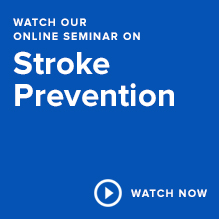What You Need to Know About TIA & Stroke
Jul 6, 2022February 4, 2018
Why Does the Brain Need Oxygen?

The brain uses energy to relay chemical signals and commands to other organ systems throughout the body. Of all the organ systems, the brain and nervous system require the most energy. The brain receives nutrients and oxygen from the circulatory system. Red blood cells use proteins like hemoglobin to transport oxygen, carbohydrates, amino acids, hormones, fats and vitamins to neural cells.
What Happens When the Brain Does Not Receive Oxygen?
When circulatory pathways are blocked or ruptured, cells do not receive oxygen and begin to die. The death of neural tissue can lead to permanent damage, and in some cases, death. The American Heart Association (AHA) identifies stroke as being the fifth-leading cause of death amongst Americans. Roughly one in twenty deaths is the result of a stroke.
What Is a Stroke?
A stroke occurs when blood vessels carrying oxygenated blood to the brain are ruptured or blocked. If blood flow is not quickly restored, brain tissue can be injured. In some circumstances, strokes are fatal. There are two kinds of strokes: ischemic stroke occurs when blockage prevents blood-flow within a vessel and hemorrhagic Stroke occurs when a blood vessel ruptures, or breaks.
Transient Ischemic Attack (TIA)
A Transient Ischemic Attack (TIA) occurs when neural blood flow is reduced for a short period of time. Similar to an ischemic stroke, a blood clot obstructs circulation and deprives brain tissue of oxygen and nutrients. In a matter of minutes clots are dissolved or pushed downstream, restoring blood flow to the brain. After a clot is dislodged, symptoms are cleared and no long-term damage is sustained. Transient Ischemic Attacks are often regarded as “warning strokes.” Though symptoms may be temporary, individuals who demonstrate warning signs of TIA should contact emergency medical professionals immediately.
The Relationship Between TIA and Stroke
Though Transient Ischemic Attacks do not result in long-term damage, they often indicate the likelihood of coming stroke. TIA indicates the presence of plaques or other clotting agents in the circulatory system. According to the American Heart Association, about one third of patients diagnosed with TIA experience an ischemic or hemorrhagic stroke within a year of their diagnosis.
The relationship between TIA and stroke occurrence is highlighted by other research, as well. A study conducted across 16 Northern California hospitals indicated that 10.5% of patients diagnosed with TIA experienced stroke within 90 days of their initial diagnosis. Along similar lines, the Journal of the American Medical Association concluded that the risk of stroke was 12-20% during the first three months following a Transient Ischemic Attack.
Preventing Stroke Following TIA
Those who have experienced TIA should take preventative measures to reduce the likelihood of stroke occurrence. Medical professionals may prescribe antiplatelet or anticoagulant medication to reduce blood clotting. In certain circumstances, minimally invasive surgery may help to expand constricted arteries. Lifestyle changes may help to reduce the risk of stroke as well. Exercise, diet, reducing stress and avoiding smoking have all been shown to lessen the chances of stroke.
